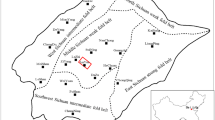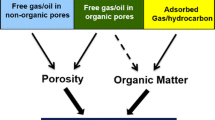Abstract
The shale oil reservoir within the Yanchang Formations of Ordos Basin harbors substantial oil and gas resources and has recently emerged as the primary focus of unconventional oil and gas exploration and development. Due to its complex pore and throat structure, pronounced heterogeneity, and tight reservoir characteristics, the techniques for conventional oil and gas exploration and production face challenges in comprehensive implementation, also indicating that as a vital parameter for evaluating the physical properties of a reservoir, permeability cannot be effectively estimated. This study selects 21 tight sandstone samples from the Q area within the shale oil formations of Ordos Basin. We systematically conduct the experiments to measure porosity, permeability, ultrasonic wave velocities, and resistivity at varying confining pressures. Results reveal that these measurements exhibit nonlinear changes in response to effective pressure. By using these experimental data and effective medium model, empirical relationships between P-and S-wave velocities, permeability and resistivity and effective pressure are established at logging and seismic scales. Furthermore, relationships between P-wave impedance and permeability, and resistivity and permeability are determined. A comparison between the predicted permeability and logging data demonstrates that the impedance–permeability relationship yields better results in contrast to those of resistivity–permeability relationship. These relationships are further applied to the seismic interpretation of shale oil reservoir in the target layer, enabling the permeability profile predictions based on inverse P-wave impedance. The predicted results are evaluated with actual production data, revealing a better agreement between predicted results and logging data and productivity.
Similar content being viewed by others
Reference
Al-Dughaimi, S., Muqtadir, A., Alzaki, T., et al., 2021, Stress dependence of elastic and transport properties in tight gas sandstones: Journal of Petroleum Science and Engineering, 196, 108001.
Benson, P., Schubnel, A., Vinciguerra, S., et al., 2006, Modeling the permeability evolution of microcracked rocks from elastic wave velocity inversion at elevated isostatic pressure: Journal of Geophysical Research, 111 (b4).
Cai, G., Gu, Y., Jiang, Y., et al., 2023, Pore Structure and Fluid Evaluation of Deep Organic-Rich Marine Shale: A Case Study from Wufeng-Longmaxi Formation of Southern Sichuan Basin: Applied Sciences, 13, 7827.
Coates, G. R., and Dumanoir, J. L., 1974, A New Approach To Improved Log-Derived Permeability: Log Analyst, 15(1), 17–31.
Deng, J. X., Wang, H., Zhou, H., et al., 2015, Microtexture, seismic rock physical properties and modeling of Longmaxi Formation shale: Chinese Journal of Geophysics, 58(06), 2123–2136.
Guo, Z. Q., Li, X. Y., Liu, C., et al, 2013, A shale rock physics model for analysis of brittleness index, mineralogy and porosity in the Barnett Shale: Journal of Geophysics and Engineering, 10(1): 1–10.
Hosseiny, E., and Mohseni, A., 2023, Garau Formation as an unconventional hydrocarbon resource in southwestern Iran: a geochemical investigation: Journal of Petroleum Exploration and Production Technology, 13, 1535–1549.
Helle, H. B., Bhatt, A., and Ursin, B., 2001, Porosity and permeability prediction from wireline logs using artificial neural networks: a north sea case study: Geophysical Prospecting, 49(4), 431–444.
Jia, C. Z., Zheng, M., Zhang, Y. F., 2013, Unconventional hydrocarbon resources in China and the prospect of exploration and development: Petroleum Exploration and Development, 39(02), 129–136.
Klinkenberg, L. J., 1941, The permeability of porous media to liquids and gases: Drilling and Production Practice, 200–213.
Khalifah, H. A., Glover, P. W. J., and Lorinczi, P., 2019, Permeability Prediction and Diagenesis in Tight Carbonates Using Machine Learning Techniques: Marine and Petroleum Geology, 112, 104096.
Katayama, I., Abe, N., Hatakeyama, K., et al., 2020, Permeability Profiles Across the Crust-Mantle Sections in the Oman Drilling Project Inferred From Dry and Wet Resistivity Data: Journal of Geophysical Research: Solid Earth, 125.
Khandelwal, M., and Ranjith, P.G., 2010, Correlating index properties of rocks with P-wave measurements: Journal of Applied Geophysics, 71, 1–5.
Lai, J., Wang, G., Fan, Q. et al. Geophysical Well-Log Evaluation in the Era of Unconventional Hydrocarbon Resources: A Review on Current Status and Prospects: Surveys in Geophysics, 43, 913–957
Liu, Q., Li, P., Jin, Z. et al., 2022, Organic-rich formation and hydrocarbon enrichment of lacustrine shale strata: A case study of Chang 7 Member: Science China Earth Sciences, 65(1), 118–138.
Lu, M., Han, T., Wang, P., et al., 2023, Permeability of artificial sandstones identified by their dual-pore structure: Geophysical Journal International, 234, 1422–1429.
Mavko, G., Mukerji, T., and Dvorkin, J., 2009, The rock physics handbook: tools for seismic analysis of porous media, Cambridge University Press.
Mulashani, A. K., Shen, C., Nkurlu, B. M., et al., 2022, Enhanced group method of data handling (gmdh) for permeability prediction based on the modified levenberg marquardt technique from well log data: Energy, 239, 121915.
Mavko, G., and Nur, A., 1997, The effect of a percolation threshold in the kozeny-carman relation: Geophysics, 62(5), 1480–1482.
Ngo, V. T., Lu, V. D., and Le, V. M., 2018, A comparison of permeability prediction methods using core analysis data for sandstone and carbonate reservoirs: Geomechanics & Geophysics for Geo Energy & Geo Resources, 4, 129–139.
Prasad, M., 2003, Velocity-permeability relations within hydraulic units: Geophysics, 68, 108–117.
Roberto, M., Dario, G., Luiz, E. S. V., et al., 2023, Iterative geostatistical seismic inversion with rock-physics constraints for permeability prediction: Geophysics, 88(2), M105–M117.
Rezaee, M., Kadkhodaie-Ilkhchi, A., and Alizadeh, P.M., 2008, Intelligent approaches for the synthesis of petrophysical logs: Journal of Geophysics and Engineering, 5, 12–26.
Shi, J., Zou, Y., Cai, Y., et al., 2021, Organic matter enrichment of the Chang 7 member in the Ordos Basin: Insights from chemometrics and element geochemistry: Marine and Petroleum Geology, 135, 105404.
Slagle, A. L., and Goldberg, D. S., 2011, Evaluation of ocean crustal Sites 1256 and 504 for long-term CO2 sequestration. Geophysical research letters, 38(16).
Timur, A., 1968, An investigation of permeability, porosity, and residual water saturation relationship for sandstone reservoirs: The Log Analyst, 9, 8–17.
Tomski, J. R., Sen, M. K., Hess, T. E., et al., 2022, Unconventional reservoir characterization by seismic inversion and machine learning of the Bakken Formation: AAPG Bulletin, 106(11), 2203–2223.
Walls, J., 1982, Effects of Pore Pressure, Confining Pressure, and Partial Saturation on Permeability of Sandstones, Ph.D. Thesis, Stanford University.
Walsh, J. B., 1965, The effect of cracks on the compressibility of rock: Journal of Geophysical Research, 70(2), 381–389.
Watanabe, T., Makimura, M., Kaiwa, Y., et al., 2019, Elastic wave velocity and electrical conductivity in a brine-saturated rock and microstructure of pores: Earth Planets Space, 71(1), 129.
Yang, H., Li, S. Y., Liu, X. Y., 2013, Characteristics and resource prospects of tight oil and shale oil in Ordos Basin: Acta Petrolei Sinica, 34(01), 1–11.
Yasin, Q., Du, Q., Ismail, A., et al., 2019, A new integrated workflow for improving permeability estimation in a highly heterogeneous reservoir of Sawan Gas Field from well logs data: Geomechanics and Geophysics for Geo-Energy and Geo-Resources, 5, 121–142.
Yang, Z., and Dong M., 2017, A new measurement method for radial permeability and porosity of shale: Petroleum Research, 2(2), 178–185.
Yale, D., 1984, Network Modeling of Flow, Storage, and Deformation in Porous Rocks, Ph.D. Thesis, Stanford University.
Zhao, X. B., Chen, X. J., Huang, Q., et al., 2022, Logging-data-driven permeability prediction in low-permeable sandstones based on machine learning with pattern visualization: A case study in Wenchang A Sag, Pearl River Mouth Basin: Journal of Petroleum Science and Engineering, 214, 110517.
Zhang, M., Dai, S., Pan, S., et al., 2023, Deciphering the laminated botryococcus-dominated shales in saline lacustrine basin, Western Qaidam Basin, NW China: Implications for shale oil potential: Marine and Petroleum Geology, 155, 106397.
Zhao, W., Bian, C., and Li, Y., 2023, Enrichment factors of movable hydrocarbons in lacustrine shale oil and exploration potential of shale oil in Gulong Sag, Songliao Basin, NE China: Petroleum Exploration and Development, 50(3), 520–533.
Zhang, G. Z., Chen, J. J., Chen, H. Z., et al., 2015, Prediction for in-situ formation stress of shale based on rock physics equivalent model: Chinese Journal of Geophysics, 58(06), 2112–2122.
Zhang, L., Ba, J., Li, C., et al., 2022, Joint inversion of the unified pore geometry of tight sandstones based on elastic and electrical properties: Journal of Petroleum Science and Engineering, 219, 111109.
Zhang, H., Zhao, B., Dong, S., et al., 2022, A Method for the Inversion of Reservoir Effective Permeability Based on Time-Lapse Resistivity Logging Data and Its Application: Geofluids, 1–13.
Acknowledgments
The authors acknowledge the supports from the National Natural Science Foundation of China (42104110, 41974123, 42174161, and 12334019), the Natural Science Foundation of Jiangsu Province (BK20210379, BK20200021), the Postdoctoral Science Foundation of China (2022M720989), and the Fundamental Research Funds for the Central Universities (B210201032).
Author information
Authors and Affiliations
Corresponding author
Additional information
Zhang Lin received his Ph.D. degree in Exploration Geophysics from Hohai University in 2020, and is working as a lecturer in the School of Earth Sciences and Engineering, Hohai University, since 2020. His research interests are the elastic wave propagation theories of porous media and pore microstructure characterization.
Rights and permissions
About this article
Cite this article
Zhang, L., Gao, L., Jing, B. et al. Permeability Estimation of Shale Oil Reservoir with Laboratory-derived Data: A Case Study of the Chang 7 Member in Ordos Basin. Appl. Geophys. (2023). https://doi.org/10.1007/s11770-024-1040-8
Received:
Revised:
Published:
DOI: https://doi.org/10.1007/s11770-024-1040-8




